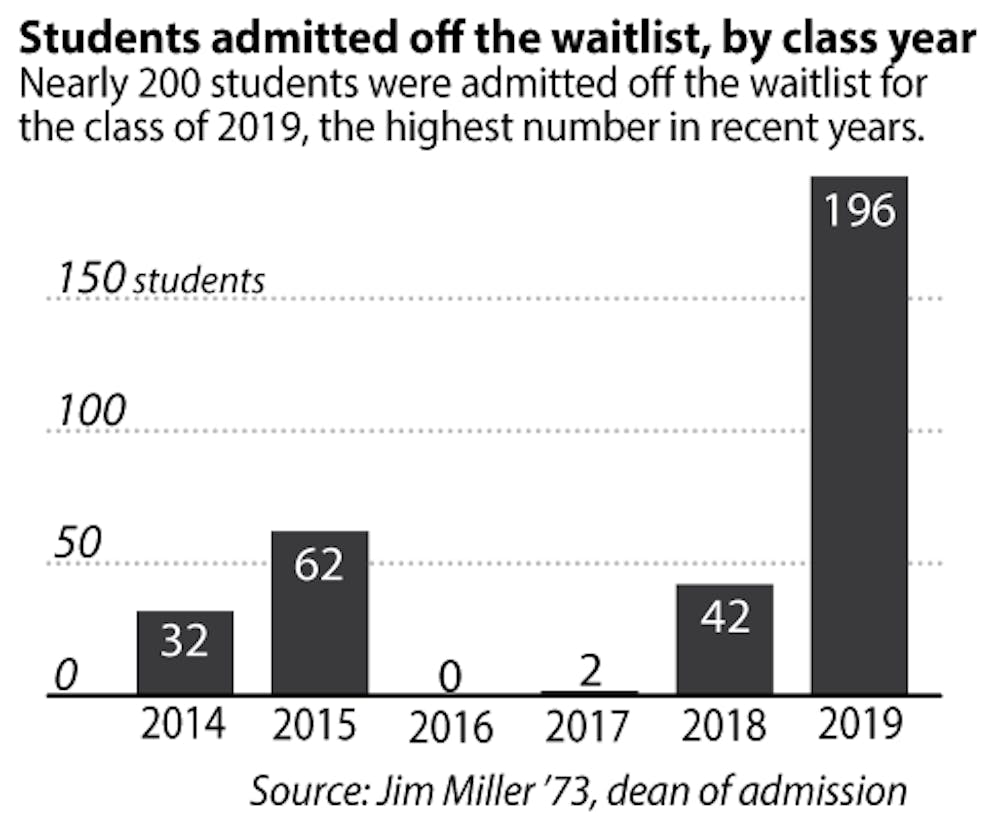The University extended offers of admission to 196 students on the class of 2019 waitlist, a drastic increase from previous admission cycles, said Dean of Admission Jim Miller ’73. A slightly lower overall yield rate and a record-high number of students deferring admission may have contributed to this jump.
Forty-two students were admitted off the waitlist last year, while two were admitted off the waitlist for the class of 2017 and zero for the class of 2016.
“It is really great to be able to take people from the waitlist because we have so many great students on there. So we’re happy about that,” Miller said.
Fifty-six percent of students admitted to the class of 2019 committed to the University, Miller said. This year’s yield marks a 3 percent decline from the previous year, though it remains close to the average of previous years, which has hovered around 57 percent, he said.
Fifty-five students accepted to the class of 2019 deferred admission to take a gap year. “This is a bigger number than we’ve ever had, which is — from my perspective — a promising trend. … I’m a big fan personally of gap years,” Miller said. This could be part of an increasing trend, as 43 students deferred admission last year and 36 deferred the year before.
The class of 2019 totals 1,618 students, including the Brown/RISD Dual Degree Program cohort of 14 students, Miller said. This marks an increase from the 1,563 students who initially made up the class of 2018. The class size has grown consistently since President Christina Paxson P’19 named growing the student and faculty populations a priority in her strategic plan, “Building on Distinction.”
Of the other Ivy League schools that have released their yield rates, Harvard, Princeton and Penn all boasted higher rates than Brown at 81, 69 and 66, respectively. Meanwhile, Dartmouth’s yield fell below Brown’s at around 50.
The yield rate for admits who attended A Day on College Hill — a three-day, two-night hosting program designed for admitted students — was 69 percent this year. Though this represents a drop from last year’s ADOCH yield rate of 73 percent, it remains significantly higher than the overall class yield rate.
Fewer participants in this year’s ADOCH — thus a smaller proportion of the overall admitted student pool — may partially explain the slight drop in yield rate. “This was due to a lot of factors that we just didn’t have control over,” said ADOCH coordinator Alissa Rhee ’16. “We had a lot of issues with overlap with our peer institutions, and this year our budget wasn’t able to extend more offers to students who maybe are coming from farther away.”
But a steadily high ADOCH yield rate is a confirmation of ADOCH’s success as a program to get students excited about Brown, Rhee said, adding that producing a high yield rate is a consistent goal for the ADOCH coordinators. “I would say this year that ADOCH was definitely a success. We had so many parents coming up to us saying that ADOCH was well-run,” she said. “The students were very happy here.”
“From a recruiting perspective, if we have the opportunity to get people to attend ADOCH, it makes a significant difference in their decision to attend,” Miller said.
Geographic location remains a major factor shaping a student’s decision to commit to a university. “There’s sort of a general rule in college admissions that the further away from home people are, the lower the yield,” Miller said. “We tend to have lower yields further away in the West Coast and the South, but that’s a general rule in higher education,” he said. This year’s class hails from 61 countries and speaks 59 languages, he added.





